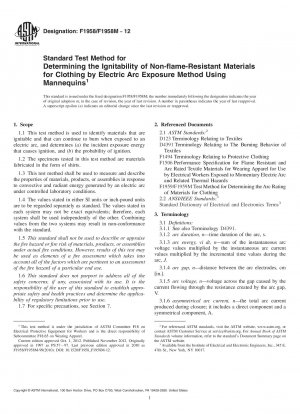ASTM F1958/F1958M-12
Standard Test Method for Determining the Ignitability of Non-flame-Resistant Materials for Clothing by Electric Arc Exposure Method Using Mannequins
- Standard No.
- ASTM F1958/F1958M-12
- Release Date
- 2012
- Published By
- American Society for Testing and Materials (ASTM)
- Latest
- ASTM F1958/F1958M-12
- Scope
- 1.1 Material performance shall be determined from the ignitability of the specimen(s) and shall be reported as a probability of ignition at various incident energy levels.
5.2 This test method maintains the specimen in a static, vertical position and does not involve movement except that resulting from the exposure.
5.3 This test method specifies a standard set of exposure conditions. Different exposure conditions may produce different results. In addition to the standard set of exposure conditions, other conditions representative of the expected hazard may be used.
1.1 This test method is used to identify materials that are ignitable and that can continue to burn when exposed to an electric arc, and determines (a) the incident exposure energy that causes ignition, and (b) the probability of ignition.
1.3 This test method shall be used to measure and describe the properties of materials, products, or assemblies in response to convective and radiant energy generated by an electric arc under controlled laboratory conditions.
1.4 The values stated in either SI units or inch-pound units are to be regarded separately as standard. The values stated in each system may not be exact equivalents; therefore, each system shall be used independently of the other. Combining values from the two systems may result in non-conformance with the standard.
1.5 This standard shall not be used to describe or appraise the fire hazard or fire risk of materials, products, or assemblies under actual fire conditions. However, results of this test may be used as elements of a fire assessment which takes into account all of the factors which are pertinent to an assessment of the fire hazard of a particular end use.
1.6 This standard does not purport to address all of the safety concerns, if any, associated with its use. It is the responsibility of the user of this standard to establish appropriate safety and hea......
ASTM F1958/F1958M-12 Referenced Document
ASTM F1958/F1958M-12 history
